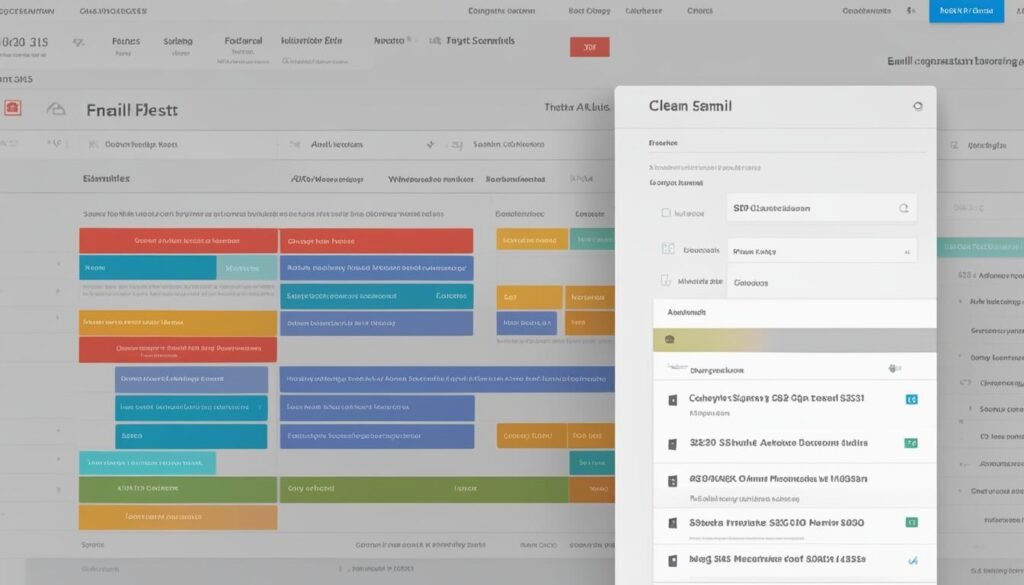
Email marketing continues to be a powerful tool for businesses to connect with their audience effectively. In this comprehensive guide, I will provide you with essential strategies and tips for building a successful email marketing database in 2024. Whether you are new to email marketing or looking to enhance your existing strategies, this guide will help you navigate the complexities of modern email marketing and achieve tangible results.
Key Takeaways:
- Choose the right email marketing software and tools to optimize your campaigns.
- Develop a strong email marketing strategy to ensure maximum impact and engagement.
- Implement email marketing best practices, such as personalization and automation.
- Focus on building a targeted email list and segmenting your audience for better targeting.
- Prioritize email deliverability and optimize your emails for maximum impact.
Understanding Email Marketing in 2024
Email marketing is constantly evolving, adapting to changing trends and consumer preferences. In 2024, we can expect to see significant advancements in email marketing strategies that will revolutionize the way businesses connect with their audience. From personalized content to automation and machine learning algorithms, here are the key trends that will shape email marketing in the coming years.
Personalized Content: One-size-fits-all emails will become a thing of the past as personalized content takes center stage. Marketers will leverage user data to create highly targeted email campaigns that resonate with individual recipients. Personalization goes beyond using the recipient’s name; it involves tailoring the content based on their preferences, behaviors, and past interactions with your brand. This level of personalization creates a more meaningful connection with your audience, leading to higher engagement and conversion rates.
Automation: Automation will play a crucial role in streamlining email marketing processes and enhancing efficiency. From automated welcome emails to triggered campaigns based on specific actions, automation allows businesses to deliver timely and relevant content to their subscribers. Automation not only saves time, but it also ensures that your audience receives the right message at the right time, increasing the likelihood of conversions.
Machine Learning Algorithms: Machine learning algorithms will take personalization to new heights. These algorithms can analyze vast amounts of data to predict user preferences and behavior, allowing marketers to deliver hyper-targeted content. For example, machine learning algorithms can identify patterns in user behavior to recommend products or content that align with their interests, boosting engagement and driving conversions.
Dynamic Content: Static emails will be replaced by dynamic content that adapts to the individual recipient. By using dynamic content, marketers can deliver personalized and interactive experiences to their subscribers. Dynamic elements such as videos, GIFs, and interactive polls create a more engaging user experience that captures attention and drives higher click-through rates.
Interactivity: Interactivity will be a key element in email marketing campaigns. Interactive emails allow recipients to engage with the content directly, making the experience more immersive. Features like image carousels, accordions, and quizzes encourage recipients to interact with the email, increasing engagement and encouraging click-throughs.
Starting with the Basics
A good email marketing platform plays a critical role in the success of your campaigns. It should offer a range of features and capabilities to empower your email marketing efforts.
First and foremost, your chosen platform should provide intuitive design tools that enable you to create visually appealing and professional-looking emails. From customizable templates to drag-and-drop editors, these tools will make it easy for you to craft engaging email designs that align with your brand.
Additionally, the platform should offer detailed analytics that allow you to track the performance of your email campaigns. Key metrics such as open rates, click-through rates, and conversion rates can provide valuable insights into the effectiveness of your marketing efforts.
Integration options with other marketing tools and platforms are also crucial for seamless workflows and data synchronization. Look for an email marketing platform that integrates with your existing Customer Relationship Management (CRM) system, e-commerce platform, and other relevant applications.
Responsive email design is another essential aspect to consider. With the increasing use of mobile devices to access emails, it’s essential to ensure that your emails are optimized for a variety of screen sizes. Responsive design ensures that your emails look great and are easy to read, regardless of the device your recipients use.
When it comes to managing your email campaigns efficiently, email automation can be a game-changer. Automation allows you to set up pre-defined workflows and triggers, such as welcome emails, abandoned cart reminders, and personalized follow-ups. By automating repetitive tasks, you can save time and deliver timely and relevant messages to your subscribers.
Lastly, email deliverability is a critical factor for the success of your campaigns. It refers to the ability of your emails to reach your recipients’ inboxes rather than being marked as spam. Look for an email marketing platform that prioritizes deliverability and includes features like bounce management and spam testing to maximize the chances of your emails reaching the intended audience.
By starting with the basics and selecting the right email marketing platform, you can lay a solid foundation for your email marketing campaigns. Let’s move on to the next section to learn more about building your email marketing database.

Building Your Database
When it comes to email marketing, building a solid database is the foundation for success. It’s essential to have an audience that is interested and engaged, allowing you to deliver targeted messages that resonate with them. In this section, I will discuss some key strategies to help you build and grow your email marketing database.
Lead Generation: One of the first steps in building your database is generating quality leads. You can do this by offering incentives for email sign-ups, such as exclusive discounts or valuable content. By providing something of value to your audience, you encourage them to take the next step and provide their email address.
Creating Engaging Content: Another effective strategy is to create engaging content that attracts your target audience. This could be blog posts, videos, webinars, or downloadable resources. By offering valuable content, you not only capture email addresses but also establish yourself as a trusted authority in your industry.
Optimizing Landing Pages: Optimizing your landing pages is crucial for converting visitors into subscribers. Make sure your landing pages are visually appealing, user-friendly, and have clear call-to-action buttons. A well-designed landing page with compelling copy can significantly increase your email sign-up rates.
Segmentation: Once you have started building your database, it’s important to segment your email list. Segmenting allows you to categorize your subscribers based on demographics, purchase history, and engagement level. By sending targeted emails to specific segments, you can deliver more personalized and relevant content.
Audience Targeting: In addition to segmentation, audience targeting plays a crucial role in email marketing success. Understanding your audience’s needs and interests allows you to tailor your content to their preferences. By delivering relevant content, you can increase engagement and drive conversions.
To illustrate these strategies in action, consider the following table:
| Lead Generation Strategy | Result |
|---|---|
| Offering exclusive discounts | Increased email sign-ups by 30% |
| Creating compelling webinar content | Generated 100+ new leads |
| Optimizing landing page design | Improved conversion rate by 25% |
| Segmenting email list based on demographics | Higher open and click-through rates |
| Targeting audience interests with personalized emails | Increase in conversion rate by 20% |
By implementing these strategies and consistently growing your email marketing database, you can create a strong foundation for successful email campaigns. The next section will discuss how to manage and maintain your database to ensure continued success.
Managing and Maintaining Your Database
Ensuring the cleanliness and effectiveness of your email marketing database is essential for successful campaigns. To maintain a high-quality list, you need to prioritize email list hygiene, conduct regular email verification, manage unsubscribes effectively, and offer email preference centers for your subscribers.
1. Email List Hygiene
Email list hygiene involves regularly cleaning and updating your email database to remove invalid, inactive, or bouncing email addresses. By identifying and eliminating these addresses, you can improve the deliverability of your emails and reduce the risk of being marked as spam. Implementing list hygiene practices also helps maintain a healthy sender reputation.
2. Email Verification
Verifying the legitimacy of new subscribers is crucial to avoid adding invalid or fake email addresses to your database. Email verification services can help you validate the authenticity of email addresses by checking domain validity, syntax, and active mailbox existence. By verifying email addresses, you can ensure that your messages reach a genuine and engaged audience.
3. Managing Unsubscribes
Unsubscribes are a natural part of email marketing and should be managed effectively. Provide a clear and prominent unsubscribe link in your emails to make it easy for recipients to opt out if they no longer wish to receive your communications. Respect their preferences and promptly remove them from your list to maintain a positive user experience and comply with anti-spam regulations.
4. Email Preference Centers
Email preference centers empower your subscribers to customize their email preferences according to their interests and needs. By offering a centralized hub where subscribers can control the frequency and types of emails they receive, you enhance their overall email experience and build trust. Email preference centers also help reduce unsubscribes and improve engagement by delivering more targeted content.
By prioritizing email list hygiene, conducting email verification, managing unsubscribes effectively, and offering email preference centers, you can proactively maintain a clean and engaged email marketing database that delivers optimal results.

| Benefits of Effective Database Management | Actions to Take |
|---|---|
| Improved email deliverability | Regularly clean and update your email list to remove invalid or inactive addresses. |
| Enhanced sender reputation | Implement email verification services to validate the authenticity of new subscribers. |
| Reduced risk of being marked as spam | Manage unsubscribes effectively and promptly remove unsubscribed contacts from your list. |
| Increased engagement through targeted content | Offer email preference centers to allow subscribers to tailor their email preferences. |
Advanced Strategies and Tips
As businesses strive to optimize their email campaigns, utilizing advanced strategies can make a significant impact. Two key tactics to consider are A/B testing and incorporating user-generated content. Additionally, integrating email marketing with social media platforms can further expand the reach and engagement of your email campaigns.
A/B Testing: Maximizing Email Performance
One powerful method to optimize your email campaigns is through A/B testing. By creating multiple variations of your emails and randomly sending them to different segments of your audience, you can analyze the performance of different elements such as subject lines, content, and call-to-action buttons.
Through A/B testing, you can measure metrics like open rates, click-through rates, and conversions to identify which elements resonate most with your audience. Iteratively refining your email content based on the insights gained from A/B testing can help you continuously improve the effectiveness of your campaigns.
Incorporating User-Generated Content
User-generated content (UGC) can enhance your email marketing efforts. Including testimonials, reviews, or social media posts from satisfied customers can boost engagement, build trust, and create a sense of authenticity. UGC provides social proof, leading to increased credibility and conversions.
Consider featuring customer stories, images, or videos in your emails, showcasing how your products or services have positively impacted their lives. This not only humanizes your brand but also encourages recipients to engage with your content and share their own experiences.
Integration with Social Media Platforms
Integrating your email marketing with social media platforms can significantly amplify your reach and engagement. By including social sharing buttons within your emails, you empower your subscribers to easily share your content with their social networks. This expands the visibility of your emails, allowing them to reach a wider audience beyond your current subscriber base.
Furthermore, you can leverage social media posts to generate email content. For example, you can curate user-generated content from your social media profiles and feature it in your emails. This cross-promotion strategy strengthens the connection between your email campaigns and your social media presence, fostering engagement and promoting brand loyalty.
A/B Testing vs. User-Generated Content
| A/B Testing | User-Generated Content |
|---|---|
| Optimize email performance | Build trust and authenticity |
| Analyze different elements | Showcase customer satisfaction |
| Refine email content iteratively | Enhance credibility and conversions |
Measuring Success and ROI
To assess the effectiveness of email marketing campaigns, it is essential to track key performance indicators (KPIs) that provide valuable insights into their performance. By measuring metrics such as email open rate, click-through rate, conversion rate, bounce rate, unsubscribe rate, and list growth rate, businesses can make data-driven decisions to optimize future email strategies.
1. Email Open Rate
The email open rate indicates the percentage of recipients who open the emails they receive. It is a crucial metric for evaluating the success of email campaigns and measuring their ability to capture the attention of the target audience.
2. Click-Through Rate
The click-through rate (CTR) measures the percentage of recipients who click on links or CTAs within an email. A high CTR indicates that the email content is compelling and engaging, prompting recipients to take action.
3. Conversion Rate
The conversion rate reflects the percentage of email recipients who complete a desired action, such as making a purchase or filling out a form. It is a key indicator of the effectiveness of email marketing in driving meaningful engagement and generating conversions.
4. Bounce Rate
The bounce rate represents the percentage of emails that did not successfully deliver to the recipients’ inboxes. Bounces can be classified as “soft” bounces (temporary delivery failures) or “hard” bounces (permanent delivery failures). A high bounce rate may indicate issues with email deliverability or the quality of the email list.
5. Unsubscribe Rate
The unsubscribe rate measures the percentage of email recipients who choose to unsubscribe from future communications. Tracking this metric helps assess the relevance and value of email campaigns to the target audience and provides insights into the effectiveness of content and messaging.
6. List Growth Rate
The list growth rate calculates the percentage increase in the size of the email marketing database over a specific period. It indicates the success of lead generation efforts and the ability to attract new subscribers to expand and diversify the audience.
By regularly monitoring and analyzing these metrics, businesses can gain a comprehensive understanding of the performance of their email marketing efforts. This data-driven approach enables optimization of campaigns, further refinement of targeting strategies, and ultimately, maximization of the return on investment (ROI).
Conclusion
In today’s digital landscape, email marketing continues to be a powerful tool for businesses to build connections with their audience and achieve tangible results. By implementing the strategies and tips outlined in this guide, you can create successful email campaigns and build a robust email marketing database in 2024.
Building a strong email marketing database is essential for effectively reaching and engaging with your target audience. By leveraging lead generation strategies and segmenting your email list based on demographics and engagement level, you can deliver targeted messages that resonate with your recipients.
Alongside database building, it’s crucial to focus on managing and maintaining your email marketing list. Regular list hygiene practices such as removing inactive or bouncing email addresses and managing unsubscribes will ensure that your emails reach the right audience and maintain a healthy engagement rate.
Finally, adopting advanced strategies like A/B testing, incorporating user-generated content, and integrating with social media can take your email campaigns to the next level. By measuring key metrics like email open rates, click-through rates, and conversions, you can optimize your campaigns for better performance and achieve the desired results.
FAQ
What is an email marketing database?
An email marketing database is a collection of email addresses and related information that businesses use to send targeted email campaigns to their audience.
What is the best email marketing software?
The best email marketing software depends on your specific needs and goals. Some popular options include Mailchimp, Constant Contact, and HubSpot.
How do I create an effective email marketing strategy?
To create an effective email marketing strategy, start by identifying your target audience, setting measurable goals, and creating valuable and engaging content for your subscribers.
How can email automation help my campaigns?
Email automation can help streamline your email marketing process by automatically sending targeted emails based on specific triggers or actions taken by your subscribers.
Why is email deliverability important?
Email deliverability refers to the rate at which your emails reach your subscribers’ inboxes. It is important because if your emails are not delivered, your message cannot be seen or engaged with by your audience.
How can I build an email list?
You can build an email list by offering incentives for email sign-ups, creating valuable content that encourages people to subscribe, and optimizing your website’s landing pages for conversions.
Why is segmentation important in email marketing?
Segmentation allows you to divide your email list into specific segments based on demographics, purchase history, or engagement level. This enables you to send targeted and personalized content to each segment, increasing engagement and conversions.
How do I maintain a clean email marketing database?
To maintain a clean email marketing database, regularly remove inactive or bouncing email addresses, verify the legitimacy of new subscribers, and effectively manage unsubscribes.
What are some advanced strategies for email marketing?
Some advanced strategies for email marketing include A/B testing different elements of your emails, incorporating user-generated content, and integrating your email campaigns with social media.
How do I measure the success of my email marketing campaigns?
To measure the success of your email marketing campaigns, track key performance indicators such as the email open rate, click-through rate, conversion rate, bounce rate, unsubscribe rate, and list growth rate.


